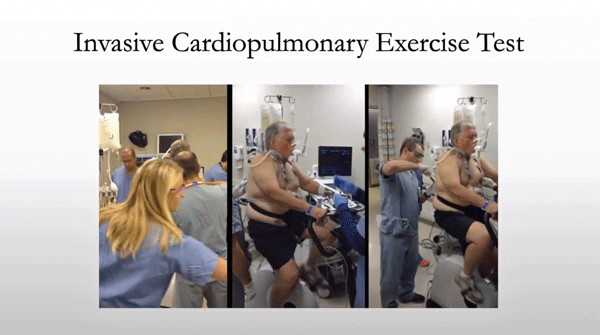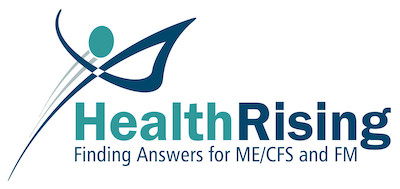

Geoff’s Narrations
The GIST
The Blog
The Recover Initiative produced an important paper! So, it is possible… 🙂 That’s a bit tongue-in-cheek. As RECOVER has started to move out of its electronic health care studies – which are not very helpful for its ME/CFS-like long-COVID cohort – it’s begun producing some interesting studies.

Suzanne Vernon led the RECOVER effort to assess rates of ME/CFS in long COVID.
Still, for the chronic fatigue syndrome (ME/CFS) community, in particular, the “Incidence and Prevalence of Post-COVID-19 Myalgic Encephalomyelitis: A Report from the Observational RECOVER-Adult Study” is something of a landmark. The study was led by Suzanne Vernon, PhD, a long-time ME/CFS researcher and Research Director for the Bateman Horne Center, and that was notable in itself.
The only reason we probably have this study is that early in the pandemic, Suzanne Vernon, on behalf of the Bateman Horne Center, reached out to the University of Utah and told them they were interested in collaborating on long-term COVID research.
Subsequently, the University of Utah included the BHC in its RECOVER application, and when the application was approved, the BHC became the recruiting center for what is now called the Mountain States PASC Consortium (MSPC). That’s how we got an ME/CFS center right in the heart of the RECOVER project.
As Dr. Vernon wrote in her blog, “COVID-19 Triggers ME/CFS,” the RECOVER project’s size provides researchers an “unprecedented opportunity” to understand the long-term effects of COVID-19. This also means that RECOVER’s results should be pretty unassailable – something we don’t see in ME/CFS. In this case, the results were good news, indeed, for the ME/CFS community.
The GIST
- Determining how many people with long-term COVID-19 come down with ME/CFS is no small thing. Studies, after all, show that ME/CFS impacts one’s ability to function like no other disease. That means that long-COVID patients who also have ME/CFS may very well end up being the sickest of them all.
- Suzanne Vernon of the Bateman Horne Center led the RECOVER-funded study. It found that most people who contracted COVID-19 completely recovered (56%) after 6 months. A large percentage (40%) still had some problems (were ME/CFS-like; had at least one ME/CFS symptom), and a small number (4.5%) met the Institute of Medicine criteria for ME/CFS.
- Four and a half percent may seem like a small number, but given how many people came down with COVID-19, it suggests that an unexpectedly large number of people have one of the most severe types of long COVID. Indeed, the RECOVER study found a significantly higher percentage of long-term COVID patients have ME/CFS than other studies.
- Overall, the study found that the coronavirus pandemic has caused a 15fold increase in ME/CFS in the U.S. – and for various reasons, that’s likely an undercount. It also found that the ME/CFS group of long-COVID patients was far worse off than the ME/CFS-like group. Plus, almost 50% of ME/CFS patients fit into the most severe long-COVID category. (The study did not include long-COVID patients who had been hospitalized).
- On a different note, you can support the effort to produce more effective ME/CFS research studies by signing a petition being circulated by the ME Association and MEAction to produce the first research definition for ME/CFS.
- Given that the ME/CFS group of long-COVID patients is so large and in bad shape, it’s a good time to take a new look at what’s happening with the $1.8 billion RECOVER long-COVID Initiative.
- RECOVER spent surprisingly little money (@5%) trying to understand the cause of long COVID, choosing instead to spend much of its money (55%) on its huge 40,000-person plus observational studies that seek to characterize it.
- To achieve that, RECOVER is putting its participants through Tier 1, Tier 2, and Tier 3 testing protocols involving over a hundred assessments and tests. Because long COVID is, from lung to heart to kidney problems to ME/CFS, RECOVER’s testing protocols had to be wide enough to capture all the subsets. Many of the tests, therefore, will not apply to the ME/CFS-like long-COVID group.
- Because RECOVER was tasked with uncovering all the long-COVID subsets, though, it also needed to provide ME/CFS-specific tests that would differentiate the ME/CFS patients from the other groups. This blog attempts to answer how well RECOVER did that.
- The key to understanding the potential of these tests is their size. With 30% and 20% of the participants slated to undergo Tier 2 and Tier 3 testing, many of these studies should be large enough to distinguish the ME/CFS group – and also find subsets within it.
- A study indicated that the simpler Tier 1 tests were worthless – and we don’t know the outcome of the Tier 2 or 3 tests. From pulmonary function to electrocardiogram to autoimmune tests, the vast majority of the Tier 2 tests are the kinds of tests that many of us have taken and have proven worthless.
- The Tier 3 tests are another matter. While many will not be helpful, the brain MRIs, cerebral spinal fluid tests, gut microbiome, blood vessel, autonomic nervous system, muscle and skin biopsy, and especially the invasive exercise tests should make the ME/CFS subset stand out like a sore thumb.
- Size, again, is so important. If these studies are large enough, they should be able to uncover subsets – and uncovering subsets, Dr. Klimas believes, is the key to finding suitable treatments for ME/CFS and long COVID.
- RECOVER did not employ many tests that could have been very helpful. They include tests that illuminate blood flows to and in the brain, energy production and oxygenation in the brain, mitochondrial functioning, immune cell functioning, blood volume, oxidative stress, or the “omics” (gene expression, proteomics, metabolomics, epigenomics) studies that have proved so helpful in ME/CFS and other diseases.
- Because understanding diseases at the molecular level has been so helpful in diagnostics and finding treatments, RECOVER’s lack of interest in profiling long COVID at the molecular level has been criticized.
- I’m a layman, but for what it’s worth, I expected RECOVER to employ one of the biggest “omics” explorations in the history of medicine to get at the beating molecular heart of long COVID-19 as quickly as possible. Instead, they chose to attempt to characterize long COVID-19 using traditional tests.
- Despite its testing lapses, I believe RECOVER will greatly benefit the ME/CFS cohort in long COVID. Its large studies should validate and extend what we know about exercise intolerance, brain issues, and gut and blood vessel issues and, hopefully, uncover subsets in each of those areas.
- The invasive exercise studies will jumpstart studies that attempt to understand the roles blood flows, oxygen uptake, mitochondrial problems, shunting, CO2 levels, etc., play in the exercise intolerance found in these illnesses. Studies exploring the role that energy production problems play in these diseases should boom.
- Because the Nath intramural study’s limited examination did not reveal significant structural abnormalities in the ME/CFS patients’ muscles, while other, more extensive muscle biopsy studies have, everything depends on how detailed RECOVER’s muscle biopsy studies are. If they’re extensive enough, these studies will spur studies into mitochondrial problems, oxidative stress, inflammation, and impaired energy metabolism.
- RECOVER should give us a clear idea of where the broken connections in the brain are, how they affect symptoms, and in which patients they occur. While blood flows into and within the brain are not being assessed, blood vessels in the brain are.
- If we get lucky—if getting lucky means uncovering evidence of misfolded proteins, neurological damage, and neuroinflammation—those results will spur more interest in the brain. While limited, the autonomic nervous system results will spur more interest in dysautonomia. With its large studies, RECOVER should be able to tell us what’s gone wrong with the gut microbiome, in which patients, and how it affects symptoms.
- Identifying subsets should enable deep dives into their molecular underpinnings, allowing for the development of biosignatures and, ultimately, treatments.
- The huge amounts of data that RECOVER is making publicly available will help computational biologists understand long COVID on a systemic level. Plus, the enormous biorepositories of samples RECOVER is collecting should prove invaluable in the long run.
- Much depends on the study size and how thoroughly RECOVER employs its testing regimens.
- Time, as always, will tell how this all turns out, but we should start seeing the results of the Tier 1 and 2 studies soon.
The Study
4,515 people in the study entered the RECOVER project within 30 days of coming down with COVID-19. Six months later, they were assessed, using the Institute of Medicine (IOM) criteria, to see if they met the criteria for ME/CFS, were ME/CFS-like (at least 1 ME/CFS symptom), or had no symptoms.
Note that this study was not designed to catch the subset of people who had been hospitalized with COVID-19 because it did not include them.
ME/CFS Explodes in the U.S.
As expected, most people who came down with COVID-19 completely recovered (56%). However, a large percentage (40%) still had some problems (were ME/CFS-like; had at least one ME/CFS symptom), and a small number (4.5%) met the Institute of Medicine criteria for ME/CFS.

Rates of ME/CFS increased 15fold in the U.S. during the pandemic
Four and a half percent may seem like a small number, but given how many people came down with COVID-19, it suggests that an unexpectedly large number of people have one of the most severe types of long COVID. Indeed, despite using more restrictive criteria (IOM criteria) than other studies, the RECOVER study found a significantly higher percentage of long-term COVID patients have ME/CFS than other studies.
Overall, the study found that the coronavirus pandemic has caused a 15fold increase in ME/CFS in the U.S. – and that’s likely an undercount. The RECOVER Initiative got going so late in the pandemic that it missed people who came down with the more severe Delta variant. (An earlier study found these patients tended to be sicker than people who got the later variants.) Because vaccination decreases the risk of coming down with ME/CFS – and most people in this study were vaccinated – people exposed to the coronavirus before the development of the vaccines probably had higher rates of ME/CFS as well. Because more severely ill patients were less likely to enroll in the study, it also missed those.
The risk of coming down with ME/CFS after COVID-19 mostly fits with what we know. People who were white, female, between 46 to 65 years of age, who lived in a rural area, were less likely to have been vaccinated or to have completed college, were at higher risk of ME/CFS. The white prevalence was surprising given that RECOVER has gone to great lengths to be representative, and most ME/CFS surveys have found greater ME/CFS prevalence in minority groups.
The study found that the ME/CFS group of long-COVID patients were: a) far worse off than the ME/CFS-like group, and b) quite distinct.
The Severe Group

Almost half the ME/CFS group fit the most severe symptom category found in long COVID.
Forty-five percent of the people who met the criteria for ME/CFS clustered in the most severe long-COVID symptom category as defined by a prior study. That 2023 study is intriguing because it seemed to suggest that most long-COVID patients have, if not ME/CFS, at least a form of it.
Note that three of the four symptom clusters defined below featured post-exertional malaise and appear to be ME/CFS-based – suggesting that the RECOVER researchers were actually measuring clusters of ME/CFS patients.
Long-COVID Symptom Clusters
- Cluster 1 was characterized primarily by loss/change in smell or taste. Those participants had the lowest symptom burden and quality of life impairment.
- Cluster 2 had PEM (99%); half had dizziness and gastrointestinal symptoms; none had brain fog (!).
- Cluster 3 was defined by the presence of brain fog (100%), PEM (99%), and other symptoms.
- Cluster 4 participants had high levels of all symptoms, including PEM, dizziness, gastrointestinal symptoms, and brain fog, and overall had the worst quality of life.
Note that most of the ME/CFS-like patients (who did not meet the IOM criteria for ME/CFS) made up a whopping 40% of the RECOVER cohort – and didn’t fit into any of the PASC categories – suggesting they may be something like a nothing burger. They were not symptomatically distinct – as one would expect a group with a severe illness to be. If that’s true, this study suggests the ME/CFS group is the one to focus on.
More than anything else, the new study reports that when a (non-hospitalized) long-COVID patient gets really ill, they essentially have ME/CFS.
Wake-Up Call for the Medical Community
Dr. Vernon wrote that the dramatic “rise in ME/CFS cases the study found” is a “wake-up call for the medical community”, and that providers will encounter ME/CFS “far more frequently”. She noted, though, that “the knowledge and tools … doctors need to identify and manage symptoms in both ME/CFS and Long COVID patients” are readily available.
Talking about definitions, a movement in afoot to produce a new, critical one for ME/CFS.
Support a New ME/CFS Research Definition

The first research definition for ME/CFS will ensure that we have more effective studies.
ME/CFS has been using a broad-based clinical definition for its research studies for decades—and that’s a no-no. Diseases typically use a narrower research definition to ensure their research studies contain only the disease in question.
After Lenny Jason and Carolyn Kingdon presented almost identical posters calling for new research criteria at the IACFS/ME conference in 2023, they’ve been working with Adam Lowe to fill that big hole in ME/CFS research and have created a petition to support that.
You can support the effort to produce more effective ME/CFS research studies by signing a petition here being circulated by the ME Association and MEAction.
The RECOVER Initiative and ME/CFS
Now that a RECOVER Initiative study has highlighted how serious the ME/CFS portion of long COVID is, what is next for the ME/CFS group of long-COVID patients – and for people with ME/CFS?
I admit that I am, on many levels, obsessed with RECOVER. The huge amount of funding it’s received, what it’s chosen to do with it, what it’s accomplishing, and what we can expect from it are never far from my mind. With President Biden and the NIH contributing another $662 million to RECOVER over the past year, RECOVER is funded through 2029. Total funding stands at a whopping $1.81 billion.
You know what they say: when you get to a billion dollars, you start talking about some real money. You know what they also say: when you’re given much, much is asked of you in return. Let’s see what RECOVER has been doing with that money.

RECOVER is betting $1 billion dollars that its observational studies will score big.
It’s surprisingly difficult to get hard figures, but RECOVER appears to be pouring most of its funding (@$1 billion) into its immense observational studies involving about 40,000 people. Three hundred million dollars are going to its clinical trials, $58 million to fund pathobiology work, and the rest to fund its huge biospecimen (822,000 samples from the adults alone), data centers, and autopsy work.
With RECOVER devoting about 3% of its funding to pathobiology studies, RECOVER is clearly not interested right now in getting at the source of long COVID. Instead, its main goal is to characterize this big and messy condition. Because RECOVER was tasked with assessing all forms of long COVID-19, its observational testing protocols had to cast a wide enough net to pluck out every type of long COVID found.
That brings us to the ME/CFS subset. RECOVER needed to find tests that would make its long-COVID subsets stand out like a sore thumb – not an easy job. Most people with ME/CFS/long COVID know the frustration of getting negative test result after test result. Indeed, ME/CFS seems almost immune to standard testing procedures. ME/CFS researchers, on the other hand, have shown that ME/CFS will show its face when the right tests are used – and that’s the big question … did RECOVER use tests that will illuminate its ME/CFS subset?
RECOVER’s Observational Protocols

RECOVER’s biggest asset is its size. Large studies could reveal long COVID as it’s never been revealed before.
RECOVER provided a list of its observational testing protocols in September 2021. Three testing tiers are present: the first tier includes many symptom assessments and is pretty rudimentary, the second tier has more involved tests, and the third tier is the most specialized. Well over 100 symptom assessments and tests are being given.
Here’s an important part. RECOVER estimated that about 30% of the cohort will get tier 2 tests, and 20% of participants will get tier 3 tests; i.e., about 5,000 and 3,000 people in its adult cohort will get the tier 2 and 3 tests, respectively. Because different clinical centers are offering different tests, the actual numbers will probably be smaller, but the gist is that RECOVER is looking at some very large sample sizes.
Tier 1 – Basic Testing
A recent study indicated that the Tier 1 testing was completely unilluminating.
Tier 2
It seems likely that most of the tests in Tier 2 will not reveal much about the ME/CFS-like cohort, either.
Unrevealing Tests – include pulmonary function, electrocardiogram, echocardiography, two chest CT scans, fecal white blood stool (diarrhea), fibroscan (fatty liver disease), a variety of autoimmune tests (RNP antibody (scleroderma), smooth muscle antibody (autoimmune hepatitis), LA antibody (lupus), RO antibody (good to see Sjogren’s in there, but the test is not very accurate), anti-dsDNA antibody (lupus), anti-nuclear antibody (general autoimmunity), anti-CCP (rheumatoid arthritis), rheumatoid factor (RA, Sjogren’s), ICAM-1 (inflammation), oral glucose tolerance test (OGTT), insulin, and c-peptide test.
Possibly Revealing Tests – Some tests that may be revealing include the limited cytokine panel (IL2 receptor; IL 1beta, 2, 4-6, 8, 10, 13, 17; interferon-gamma, TNF alpha), the ICAM-1+, and the EBV+ tests. (No information is given on what the EBV+ test is testing for.)
Tier 3
Things get more interesting at Tier 3. If 20%, 10%, or even 5% of the 15,000 adults in the RECOVER project get Tier 3 testing, RECOVER should have plenty of room to dig out specific subsets.
Serum protein immunofixation electrophoresis+ – measures proteins – particularly immunoglobulins – in the blood. Significant changes in blood serum proteins associated with immune system activation, altered coagulation, and tissue damage have been found in long COVID. This test has not been assessed in ME/CFS.
Complete neurocognitive testing+ – specific cognitive tests have been needed in ME/CFS … will RECOVER use them?
EndoPAT testing (Endothelial Peripheral Arterial Tonometry) – assesses blood vessel functioning – could be very revealing.
Serum B12/Methylmalonic acid+ – B12 status – low B12 can produce unexplained fatigue or weakness, tingling, numbness, or memory issues. One ME/CFS study found high B12 – perhaps because of sedimentation. Probably not very revealing (?)
CPK, Aldolase, and Myositis Panel Tests – evaluate muscle inflammation, damage, or autoimmune myopathies. It would be surprising if these tests captured much, but one study did find increased CK levels in ME/CFS. (Is a muscle inflammation subset out there?)
The Brain and Central Nervous System
Cerebral Spinal Fluid
Things get moving with cerebral spinal fluid (CSF) tests. CSF test results have been quite variable in ME/CFS and long COVID, but with perhaps 1000s of patients assessed, these tests could pluck out some intriguing subsets.
- Protein levels – assess the integrity of the blood-brain barrier (BBB), detect inflammation, and identify conditions affecting the central nervous system. Abnormal CSF protein levels have been associated with a variety of neurological diseases. Test results in long COVID and ME/CFS have been variable. Mildly elevated protein levels in both conditions suggest subtle blood-brain-barrier problems or mild inflammation. Elevated levels of specific proteins (e.g., IL-6, IL-8, or other inflammatory markers) in some patients suggest neuroinflammation is present.
- GFAP – demonstrates astrocyte damage in the brain. Two studies have found increased GFAP levels in ME/CFS or long-COVID patients.
- Neurofilament light chain – a biomarker for neurological damage. One study found increased NFL levels in long COVID and borderline increased levels in ME/CFS.
- AB40, AB42, and pTau – are cerebrospinal fluid (CSF) biomarkers primarily used to assess Alzheimer’s disease (AD) and other neurodegenerative conditions. Reduced Aβ42 levels in some ME/CFS and long-COVID patients could reflect neuroinflammation and/or increased amyloid deposition. Similarly, elevated pTau levels in long COVID could indicate neuroinflammation and early neurodegenerative changes.
Other Brain Tests
- Lumbar puncture (overlaps with brain CSF findings): In addition to finding subtle immune abnormalities, lumbar punctures have found increased CSF pressure in ME/CFS, a potentially major finding.
- Brain MRI with and without gadolinium – A brain MRI without gadolinium will probably be uninformative as it assesses structural issues that, to my knowledge, have not been found. The brain MRI with gadolinium, however, can uncover blood-brain-barrier disruption, active inflammation, and vascular abnormalities—exactly what we’re looking for. Without going into the many brain MRI findings in ME/CFS, FM, and long COVID, it suffices to say that numerous abnormalities have been found, and these tests done in large numbers could be very informative.
Others
- Cardiac MRI with and without gadolinium – reduced preload and small hearts have been found in ME/CFS and/or long COVID. Cardiac MRIs don’t do a great job of showing preload failure caused by reduced blood volume – which is what is found in ME/CFS and long COVID – but can infer it. MRIs are good, however, at uncovering small hearts, which have been found.
- Nerve Conduction – probably not illuminating as it assesses large nerve functioning and the small nerve fibers are more affected in ME/CFS and long COVID.
- Skin Biopsy – will uncover small fiber neuropathy – which we already know is present.
- Muscle Biopsy – How helpful these will be depends on how thorough the assessment is. Muscle biopsies in both ME/CFS and long COVID have found evidence of mitochondrial dysfunction, oxidative stress, and muscle fiber atrophy.
- Facility-based polysomnography (sleep test) – Results depend on the type of sleep study done. Nothing particularly novel is expected of this, but it should illuminate basic sleep problems.
- Autonomic testing – Tilt table testing, including supine and upright plasma catecholamine levels, heart rate variability (cardiovagal innervation testing), and the Valsalva test. Again, there is nothing novel about this quite limited testing regimen. It will help establish rates of postural orthostatic tachycardia syndrome (POTS), neurally mediated hypotension, and others.
Invasive CPET

Getting the invasive exercise test into RECOVER was a huge win.
Including the iCPET in the Tier 3 tests in 2023 was a big shock. This test can illuminate what’s happening in ME/CFS and long COVID like few others can. Coming straight out of David Systrom’s work with ME/CFS, the iCPET is ME/CFS’s gift to long COVID. It was great—and surprising—to see the RECOVER project take it on.
The iCPET hits at the heart of ME/CFS and long COVID—the inability to produce energy. Possible mitochondrial and oxygen utilization problems, blood vessel problems (blood loss), cardiac abnormalities (not due to the heart) such as reduced stroke volume and preload (reduced amounts of blood leaving and/or entering the heart), and breathing abnormalities (reduced CO2, breathing patterns) can all show up.
Not only should the iCPET test rapidly distinguish between the long-COVID ME/CFS patients and the others, but it will also point the finger at energy production, oxygen utilization, blood flows, and breathing patterns. Its presence is a big win for long COVID.
Gut
- Stool Microbiome – Gut dysbiosis (dysfunctional gut microbiome) has consistently been found in both ME/CFS and long COVID. Both conditions show reduced diversity, increased pro-inflammatory bacteria, and reduced short-chain fatty acids (SCFAs, such as butyrate). Altered gut bacteria could contribute to neuroinflammation and problems with energy production.
- Gastric emptying—delayed gastric emptying ( movement through the GI tract) has been found in some long-COVID and ME/CFS patients. Because gastric emptying problems can reflect autonomic nervous system and microbiome problems, this is potentially a valuable test.
- Fecal calprotectin – assesses intestinal inflammation; studies are sparse, and results are mixed.
- Anti-Mullerian hormone – an interesting choice. Anti-mullerian hormone reflects reproductive health. It has not been assessed in ME/CFS or long COVID but could be impacted given the gynecological issues found.
The Missed Tests

RECOVER missed some opportunities to definitively characterize ME/CFS.
Unfortunately, RECOVER missed many potentially valuable tests. Not using provocation (exertion) stressors in at least some participants to illuminate this exertion-challenged disease was a big miss. Employing transcranial Doppler tests to assess blood flows to the brain would have been eye-opening. Given how helpful they’ve been in ME/CFS, the fact that RECOVER is not employing metabolic tests in any fashion seems bizarre. Ditto with immune tests; besides the cytokine panels, I didn’t see any immune tests.
The list of potentially valuable tests goes on: SPECT, PET, magnetic resonance spectroscopy (MRS), functional near-infrared spectroscopy (fNIRS), blood volume, mitochondria, oxidative stress, microclots, EBV duTPase, HHV6, and probably many others have been helpful in ME/CFS and would surely have illuminated the ME/CFS subset of long COVID and produced fascinating results. The loss is major. Check out what some of these studies have found
- Transcranial Doppler – reduced blood flows to the brain when upright in virtually everyone with ME/CFS
- Metabolic Findings – reduced fatty acid oxidation, altered amino acid metabolism, impaired tryptophan-kynurenine pathways, impaired energy production in several cells.
- SPECT scan – reduced blood flows and reduced oxygen uptake in parts of the brain
- Magnetic resonance spectroscopy (MRS) – elevated lactate levels, impaired energy metabolism in the brain and muscle
- PET scan – neuroinflammation, hypometabolism
- Functional near-infrared spectroscopy (fNIRS) – reduced cerebral blood flows and reduced oxygenation in the brain and muscles
- Mitochondria – reduced ATP production, reduced respiratory chain efficiency, reduced aerobic energy production, reduced mitochondrial production, increased levels of oxidative stress
The Mysterious Missing Molecular Investigation
Surprisingly, aside from the microbiome assessment, none of the ‘omics’ tests (genomics, transcriptomics, metabolomics, proteomics) were included. These may be expensive tests, but they have “revolutionized” diagnostics and are producing much of the progress in the ME/CFS field. Getting at the molecular heart of long COVID will require using these tests.
Nisha Viswanathan, MD, the director of the Long COVID Program at UCLA Health, believes so. Speaking to Medscape, she asserted:
“We need to have large-scale research at the molecular level to find treatments that could lead to long-term sustained remission of long COVID rather than just managing symptoms … If we don’t develop a better understanding of the disease’s mechanism and how to diagnose it at a molecular level, we’re never going to truly be able to treat it”.
A Backwards Approach?

Should RECOVER have gone molecular?
For me, RECOVER got it backwards… Faced with a puzzling new disease, I expected RECOVER to employ one of the biggest “omics’ explorations in the history of medicine. With all the omics and data mining tools now available, long COVID-19 seemed like the perfect test case for how to get at the beating molecular heart of a new disease as quickly as possible. Once you get there, as Dr. Viswanathan noted, the diagnostics and treatment possibilities should open up.
If it worked, RECOVER might be on the road to uncovering diagnostic biomarkers for its subsets, new research avenues, and new treatment options. Instead, RECOVER has relied on a very large observational program and a testing regimen that, at least at this point, doesn’t seem to fit the ME/CFS-like portion of its cohort all that well.
The observational component of the program will certainly produce results. The benefits of large-scale invasive exercise studies are large and obvious. So, too, the brain MRI, gut microbiome, and endothelial functioning studies. Many of the others (cerebral spinal fluid components, CPK, aldolase, and myositis panel, fecal, serum protein immunofixation electrophoresis+) seem more like stabs in the dark, which may or may not work out.
Instead of putting all its eggs in one big and very expensive testing basket, RECOVER could and should have created a smaller, side experimental testing regimen that examined more unorthodox tests, intending to incorporate successful ones into the larger testing protocols. Doesn’t a new disease entity call for something like that?
Likewise, instead of producing smaller rounds of experimental clinical trials, which could have progressed to larger rounds, or using a more efficient approach like platform trials, RECOVER put all its eggs into producing 15 large, very expensive, mostly uninspiring trials. (Note that RECOVER now embraces a more nimble approach to clinical trials.)
RECOVER’s sheer size potentially confers real benefits. Its strategy was apparently to build the foundation of a field; that is, to create a broad database of results that will feed researcher interest for years.
How well RECOVER accomplishes its aim, though, depends entirely on how wisely it chose its testing regimen. Note that RECOVER severely limited its testing options by following so many participants (40,000) – and one wonders if some sort of statistical prerogative drove its decisions. Note that the $763 million RECOVER originally allocated to its observational cohort was insufficient, and it needed to add over $300 million more to finish that part of the study.
Questions will continue to be asked about RECOVER’s return on its enormous investment ($1 billion+) in its large observational cohort. Does more evidence that POTS, sleep problems, cognitive difficulties, HRV abnormalities, and small fiber neuropathy are present move the field forward? Since we already know that long COVID increases the risk of autoimmune diseases, did RECOVER really need to do its autoimmune tests?
Time will tell what RECOVER’s return on investment will be. If RECOVER’s tests illuminate the ME/CFS-like group of long-COVID patients well, they will provide the field with a strong base. Over the next year or two, RECOVER should be done assessing its Tier 2 and 3 results, and we’ll know more.
A Big Help?

Time will tell, but RECOVER’s long-COVID initiative could be quite helpful.
Even with its rather paltry testing regimen, I think RECOVER, with its big cohorts, may ultimately help a lot. Over the next few years, RECOVER should validate and extend what we know about exercise intolerance, brain issues, gut and blood vessel issues, and, importantly, uncover subsets in each area.
The invasive exercise studies will jumpstart more studies that attempt to understand the roles blood flows, oxygen uptake, mitochondrial problems, shunting, CO2 levels, etc., play in the exercise intolerance found in these illnesses. Studies exploring the role that energy production problems play in these diseases will boom.
Because the Nath intramural study’s limited examination did not reveal significant structural abnormalities in the ME/CFS patients’ muscles, while other, more extensive muscle biopsy studies have, everything depends on how detailed RECOVER’s muscle biopsy studies are. If they’re extensive enough, these studies will spur studies into mitochondrial problems, oxidative stress, inflammation, and impaired energy metabolism. That would be a huge boon.
We’ll have a better idea of where the broken connections in the brain are, how they affect symptoms, and in which patients they occur. While blood flows into the brain and in the brain itself are not being assessed, blood vessels in the brain are. If we get lucky—if getting lucky means uncovering evidence of misfolded proteins, neurological damage, and neuroinflammation—those results will spur more interest in the brain. While limited, the autonomic nervous system results will spur more interest in dysautonomia. With its large studies, RECOVER should be able to tell us pretty conclusively about what’s gone wrong with the gut microbiome, in which patients, and how it affects symptoms.
The identification of subsets will enable deep dives into their molecular underpinnings, allowing for the development of biosignatures. The huge amounts of data that RECOVER is making publicly available will help computational biologists understand long COVID on a systemic level. Plus, the enormous biorepositories of samples RECOVER is collecting should prove invaluable in the long run.
Time will tell!
Health Rising’s End of the Year (Beginning of the Year) Donation Drive is Done!
Thanks to the hundreds of people who supported us! After I thank everyone and collate all the results, I’ll let you know the totals. I think we did just fine! 🙂






Great piece!
Off topic – do you know when Simmaron’s results on their rapamycin trial will be announced / published?
No idea, I’m afraid but the fact that they’re expanding the study is hopeful 🙂
Are you able to ask? (Please)
Your status must have some sway. I emailed them a week or two ago but didn’t get a response. I assume you know Peterson?
I want to see treatments. After 34 years, I am a bit tired (literally and metaphorically) of study after study that seldom advances things. I don’t want mu daughter to go through 34 years of this.
Polybio are also doing a trial. So there-must be something in this.
I’ll see what I can find out about the status of the trial. 🙂
Hi Matthias – I asked and yes, there is a lot going on. A blog is coming up!
You and me – we’re the long, long haulers! My health, as I knew it, disappeared when I was in my early 20’s. I never imagined it would last this long…
Thanks Cort!
My first 3-4 years of the illness were moderately bad, since then I have what you could say is ‘mild’ CFS. Having said that, it still impacts my life, especially in terms of exercise. I try to have a mindset of gratitude that I have a mild form of this illness.
50+ years here. From the included/excluded testing over time, and the sheer amount of time the research or weakness of it has continued, the conclusion appears more obvious as time continues ~ the cause(s) of ME/CFS are not being authentically pursued. Testing, and diagnosis, increasingly appear to have been circumvented.
Thanks for another interesting article, Cort.
No NASA Lean Test? It’s cheap, doesn’t need to be conducted by a doctor, and works for quite a few types of OI. Should be at Tier 1. Also, even at the Tier 4 level, no Doppler ultrasound for cerebral blood flow means they will miss all the people with ME/CFS who have OCHOS, which Visser, van Campen & Rowe have shown is a significant number.
Yes – I agree – at Tier 1. At the very least it would help people know what they have quickly. The Doppler ultrasound would have been so informative! Ach! That would have opened up a lot of eyes.
I have had ME/CFS since Sept 2023. I went from being the most active person, playing pickleball 2-3 hrs a day, going to 3 exercise classes a week and spending hours working in my yard, to barely getting out of bed for months. The last few months I improved somewhat and on “good” days, could buy groceries, etc.as long as I didn’t have to stand very long.
I have wanted to get into a clinical trial but don’t know how. I contracted COVID 3 weeks ago for the first time. I’m having a hard time getting over the symptoms and am worried I’m back to where I was when I contracted CFS.
Sorry to hear, Joanne! Yes, you can still get COVID! I am continuing to mask up in busy places. Three weeks is not so abnormal – hopefully it’s still just working its way out. Good luck!
Hi Joanne, you could consider signing up for StudyME, the Open Medicine Foundation’s patient registry. It is open to people internationally, with the aim of connecting researchers and participants for studies/trials. There’s no commitment when you sign up, it just allows them to contact you if there’s anything in your area. https://www.omf.ngo/studyme/
You can also ask your GP or any specialists you have if they know of any studies you can help with – they often won’t think to bring them up without prompting – that eventually led me to one study invite (unfortunately screened out), and another I’ve been on a waitlist for (so many delays to them starting!)
Good luck!
Thanks for the info. I will definitely sign up.
Joanne, I also suggest taking a look at the Bateman Horne Center website. There is a plethora of information and education there as well as talking points with your provider.
This is a hopeful piece, for the majority of LC sufferers. What is still missing from the classification system is recognition of the early 2020 cohort of LC that experienced a more neurologically damaging virus causing severe dysautonomia and neuropathies, which can have occurred with OR without any of the symptoms of the other classes. This version is marked by dysautonomia involving severe and constant sympathetic activation, resulting in stress on all parts of the body, severe cognitive challenges, sensory abnormalities including internal vibrations and nerve firing (constant and like torture no-one can see), pressure on major organs – but not necessarily CFS/ME, loss of taste or smell, or POTS.
Generally lacking any early treatment or vaccination, this group also frequently has developed over time autoimmune responses to multiple exposures to the mRNA vaccines and additional bouts of COVID, leaving us uniquely vulnerable until alternative (e.g., protein, nasal) vaccines are made available. Early papers are out identifying this group but they are not seriously being considered for treatment or inclusion in cohort studies. We have been turned away from ERs, hospitals, specialists etc. who don’t recognize us as LC or have no idea how to treat us. We need better access to dysautonomia specialists who are not solely focused on CFS/ME and POTS.
I know these groups are long overdue for recognition and effective treatment so am just as excited and happy that they are finally getting the attention they always should have. Please don’t forget about us though – we never really had a chance to avoid our exposures and we are entering end-game with heart failure, digestive failures, full-body neuropathy, etc.
Darn! You were not only exposed to the worst of the virus… but nobody knew how to deal with it – and now you are in limbo.
I don’t believe RECOVER has early long haulers in the study. We’re trying to get ME/CFS patients in there.
Did you hear about Nancy Klimas’s study – which used an monoclonal antibody that targets people with early strains of the virus. It was very effective – and she has begun a larger study.
https://www.healthrising.org/blog/2023/11/29/monoclonal-antibodies-long-covid-chronic-fatigue-syndrome/
Hi Teresa and Cort, there are early Long COVID people enrolled. They are the post acute group which means they enrolled >30 days after their acute SARS-CoV2 infection. Many were infected in early 2020 and developed Long COVID. This is an important group that will be studied
Nice! That is so good to hear – thanks!
Suzanne, since you are here – thank you for your work on the oxaloacetate study. It was interesting that around 40% of the trial participants received good to very good benefits. But then 60% essentially received no benefit.
Interested to know the progress of your work in understanding why this might be so? I would give oxaloacetate a try, but right now it’s a toss of the coin as to whether it might be effective. So it would be good to know for whom it might be more likely to be effective for. It’s an expensive supplement!!!
Hello Suzanne, Teresa and Cort ~ any thoughts on late 2019 COVID cases?
Novavax is a protein based vaccine that is currently available in most communities. Next year they hope to offer a Covid/flu combination shot.
I would like to see a big study like this lead to more specialists. For instance, my neurologist says he treats dysautonomia. I know – from comparing his limited suggestions to what I can get on Bateman-Horne and also Dr. Svetlana Blitshteyn’s slides and guidelines – that he does not.
All I can say is ‘thank God Fauci has gone’. Is it normal for the head of the NIH to need a blanket presidential pardon as he goes out of the door?
He may well have had influence on not including the onomics in the thiscstudy as he had insider knowledge of the origins of Covid and the vaccine manufacture. All this makes it suspicious about the limitations of the study and his PARDON which effectively also prevents more knowledge entering the study chains.
The people should rise to have that pardin rescinded due to the millions more who died due to mismanagement of covid worldwide. Far greater than the Hitler extermination.
It us up to the people of the USA to have that pardon rescinded.
Thanks Janet and others who responded to my comment. I must admit I hadn’t intended to open up the whole vaccine thing !!! but I do think Fauci and the NIH have been playing us for years, saying the right things, some honeyed words, and then making darn sure nothing much changes. Long covid was a perfect opportunity to do all that ‘omics’, flow cytometry etc stuff that we can do now so easily but couldn’t years ago during earlier ME/CFS outbreaks. Moreover, research into the pathology of the disease would surely be the default approach e.g. HIV, cancer etc. rather than a lot of what they have done. Truth is, it was more about dishing out the funding to the usual institutional interests rather than following the science.
On a more positive note, when I watch the updates from Polybio I realise what the NIH should have been doing years ago, but am also heartened that some good progress is being made.
Thanks, Nigel – I think we could use our limited energy on better things 🙂
“Long covid was a perfect opportunity to do all that ‘omics’, flow cytometry etc stuff that we can do now so easily but couldn’t years ago during earlier ME/CFS outbreaks.”
I would so like to know why RECOVER didn’t go this route. I’m sure they had a reason but at least to this layman it seems to make so much sense. Maybe they thought it wouldn’t work – I don’t know.
It’s inexplicable to me that the news media hasn’t asked these kinds of questions or focused on RECOVER much. Did RECOVER really need to follow 40,000 people? That number must drastically limit how many tests they can do. How about 20,000 and add omics studies in there? I would love to know why they chose to do what they did.
My thought was to dive into the pathophysiology first – and use the results to drive treatments. Instead they are diving into it last…
We can certainly agree on that!
Cort ~ very much agree on your observations and thoughts. While some may view them as conspiracy theories, that didn’t even occur to me, but rather that you’ve expressed a logical train of thought, reason, and curiosity.
Cort, I’m grateful you asked the question of why they followed so broadly and tested so little instead of going straight to diagnosis tools. For those of us familiar with the ineffective routines wrapped around this illness like a cocoon, it makes little sense.
The one thing that might make sense to me is if they felt it important to start by proving its importance. Taking a broader pulse does allow them to establish the prevalence of the condition. Perhaps in hopes of using prevalence to gain future funding. And starting with all the ineffectual tools might also provide a foundation for saying “see, doctors don’t have the tools they need” as well as “see, this can’t be picked up like most other diseases can.”
Just hypothesizing, of course. But this is the one way it kinda does make sense to me—frustrating though it is that they didn’t have a carpe diem attitude in the direction of moving testing/diagnosis forward!
(Conspiracy theory – personal attack – part of comment removed)
Many are starting to advance, though, and the truth will out per new Administrations and greater freedom of the press with less censorship and greatly more transparency.
Meanwhile, folks are baffled that ME, turbo cancers and the like have exploded since the introduction of the jabs and their gene-altering ingredients. Fully conventional medicine folks who point out unpopular opinions and questioning in this forum and others are often labeled, and attacked, as conspiracy theorists. That carefully controlled meme is quickly going obsolete.
Semmelweis was branded a quack for pleading for hand washing before infant deliveries by prisoners of medical orthodoxy at the time. 100 years ago Congress passed the corporate-oriented Flexner Act, which outlawed natural medicine, women and people of color in medical schools, and the entire body of homeopathic paradigm medical colleges. The oligarch controllers of the day knew there was profit only with their total control of medical curriculums.
Hundreds of other examples of the lack of critical questioning still rule corporate medical programming. The “safe and effective and fully tested” shots were not. Too many ill people are running out of time; the positive changes in medical orthodoxy and bureaucracy are way too slow, considering that the harmful pandemic treatments were approved almost overnight with billions of profit dollars for those who controlled the info streams and media.
There is much hope for chronically ill people who understand and undertake natural and integrative approaches to healing, plus the healing value of questioning an outdated medical paradigm. Until a new and effective healing paradigm and its positive changes are fully installed, this healing journey will be ongoing.
Cort deserves praise for his great lifetime dedication and focused approach to ME/CFS. It is not the major route that has helped me. Many healing avenues work well together; I wish speedy wellness for everyone here. It will take much more open minds to get past the corporate and bureaucratic greed slowing down insurance covered natural approaches.
WHO ARE THE QUACKS?
Decades of combing the internet led me to know who the real QUACKS are.
Royal Rife had the answer to cancer but the AMA made short order of that.
It’s what has made me keep trying different things. I know that the truth will keep getting clouded by money.
To think their are people this evil in our times is frightening. The gap between rich and poor is forever widening. Our only hope is private funding.
Just so everyone knows – we’re not going to go down the Fauci conspiracy path again – or vaccine conspiracy hole – it’s exhausting and doesn’t lead anywhere. The next one gets deleted. Let’s focus on other stuff.
Thank you Cort that wise decision!!!
Thank you
With the new administration pausing so much NIH research “immediately and indefinitely” during just their first week in office, how much of this will actually go ahead? While RECOVER may have been funded right through to 2029, as a Long Hauler looking out from Canada, I’m not so optimistic any longer. Would love to hear your thoughts on this.
I heard about that. I did read that administrations sometimes do this and it may be just that. If what we’re seeing is a politicization of science; i.e. if your results don’t agree with my beliefs or what I want to hear – then America is in bad shape, indeed, if that is allowed.
That’s like the death of progress! How can we move forward without looking at things objectively? One of the things that sets us apart is that we produce rigorous, objective, fact-based science.
Time will tell…
I think we have to also remember the non ME/CFS subsets of long COVID, one of which is fibromyalgia-like. Maybe some of these tests could be helpful though also lacking others. And I wish they’d rerun the study you covered here and use fibromyalgia criteria to see what the prevalence is, since there is a lot of overlap there for long COVID, too.
It’s amazing how forgotten fibromyalgia has been in long COVID. I’ll bet though, that a pain contingent will show up – it practically has to if the right questionnaires are being used.
If RECOVER does its job – and I can’t imagine that it’s not in this area – it should just emerge.
What a well-constructed piece of informative writing.
Thanks Cort.
It makes me dizzy thinking of the study subjects going through so much testing….particularly the more stressful and invasive stuff.
Being exposed to that regimen of tests etc must be daunting!
(A good dose of gadolinium will certainly challenge the kidneys! I hope they do more good than harm. )
Agree – Well done to the participants of this study for putting themselves forward for this daunting & – quite frankly – frightening (for a person with LC/ME/CFS) series of tests which – am sure – will have come at high personal cost to their own health status.
Thank you so much Cort for this very informative & hope filled post.
Hi Cort,
I thought you might be interested in reviewing this publication. I’ve been in contact with Prof. Dr. Suler and am currently in the process of finding a neurologist who understands the connection between muscle weakness and DYSF methylation. This is part of my efforts to secure a referral to the Max Delbrück Center in Berlin.
The mechanism appears to involve the following:
“When FHL contracts a virus—such as the Epstein-Barr virus (EBV) or other similar viruses—the cytotoxic T cells are unable to eliminate the infected cells.”
Here’s the link to the publication for reference: https://www.mdc-berlin.de/news/press/gene-editing-precisely-repairs-immune-cells
Gene editing precisely repairs immune cells.
Fascinating stuff! It seems quite apropros. Thanks for the link. A talk with Liz Worthey – a person who has been looking into hereditary gene issues in ME/CFS and long COVID – is coming up. I sent it on to her.
It sounds like CRISPR is going to move mountains…
“Some hereditary genetic defects cause an exaggerated immune response that can be fatal. Using the CRISPR-Cas9 gene-editing tool, such defects can be corrected, thus normalizing the immune response”
So much stuff to write about…anyone up for a guest blog?
Hi Cort, thanks.
A substantial body of literature has been written about ME/CFS, with numerous “cures” proposed. Yet, the root cause of this condition remains elusive. This stagnation is likely to persist unless research focuses more intently on inherited and methylated genes.
Engaging with the existing scientific knowledge demands not only a willingness to read but also the discipline to critically analyze and apply the findings. Without such rigor, treatment approaches risk exacerbating the condition or introducing new complications. A genuine solution can only emerge through the identification and targeted investigation of the underlying cause.
Over the years, I have conducted my own explorations, uncovering links between symptoms and various pathogens, including viruses, bacteria, and fungi. These findings have prompted me to consider how such agents may fundamentally impair the human genome, potentially altering its function through inherited or acquired mechanisms.
After enduring years of suffering, navigating false diagnoses, and dealing with the consequences of misguided and uneducated treatment recommendations—many of which led to additional comorbidities—I am now taking a new step forward. Specifically, I am seeking confirmation of DYSF methylation.
To this end, I contacted Prof. Dr. Spuler, who kindly responded, stating:
“Would you need another effort to reach a correct, maybe genetic diagnosis? You are welcome to get an appointment in our Charité Outpatient Clinic.” (https://www.mdc-berlin.de/spuler)
This represents a significant opportunity to move closer to an accurate diagnosis and a deeper understanding of the mechanisms and potential causes of muscle weakness underlying ME/CFS.
Sieglinde
You write that there is an explosion of ME/CFS patients. Don’t you mean long covid patients? ME/CFS is not the same as long covid. And what about all those post-vaccination long covid patients? There are clearly many things that are intertwined in this research. Patients who were unvaccinated and developed long covid after the Delta variant. vaccinated patients who still got long covid most – so those vaccines apparently don’t work that well, apart from all that vaccine damage – and ME/CFS patients. This makes it very difficult to research these groups together. I find it a very confusing study.
This study assessed how many people who were infected with the virus met the criteria for ME/CFS. They may or may not have a different type of ME/CFS – there are certainly subsets in ME/CFS – but they also have ME/CFS (the long COVID version).
The study found – as other studies have – that vaccination reduced the risk of coming down with long COVID; i.e. that vaccinated people had less of a risk.
I asked ChatGPT and it said that several studies suggest that vaccination reduces the risk of coming down with long COVID about 70% (!). I didn’t realize it was that high…
Is ChatGPT the truth these days :-)Let’s not start a discussion about the mRNA vaccine. 70% or what? Which study? Let’s take a closer look at the excess mortality that is still going on. And all the sudden deaths. The increase in cancer, autoimmune diseases, cardiovascular disease and blood clots. It doesn’t seem to me that the mRNA vaccinations are so harmless. Let everyone who has been vaccinated test their IG4.
Look it up, Gijs! I have given links to these studies before – so if you want to know – either look it up on Health Rising or look it up on PubMed or on ChatGPT which gives the links to the studies. You are not going to take it on board anyway – so why waste my time and energy doing this once again? You’ll be back min a month crying foul again.
Your response says a lot Cort, If you claim that 70% of the mRNA covid vaccines could prevent ME, wow that’s quite a statement! That would be world news, don’t you think? Too bad you’re starting to become offensive. But it’s starting to look like disinformation. There is no explosion of ME. We cannot even measure ME objectively. One more time: Long Covid is not ME and vaccination is not harmless. Your IG4 has also been too high for a while after boosting, right? Just ask a good immunologist what that means. Don’t lose yourself in all those figures and studies. CBT is also said to ensure recovery for 70% of ME patients, remember that study in The Lancet.
What ridiculous comments. No-one has ever claimed vaccinations are harmless – they are however, on the whole, vastly safer than the various health risks that come with the illness they are protecting against, as is the case with Coronavirus. As for saying ‘One more time’ that Long Covid is not ME’, no matter how many times you say it, is disingenuous – we know for a fact that a significant proportion of those with Long Covid now fulfil the diagnostic criteria of ME – it is that simple. You say we cannot measure ME objectively – we well know the symptoms that define this condition, and there are millions of us with it. We also know a vast amount of people have contracted Covid over the past 5 years and know that a significant number of these people now fulfil the criteria for ME – so that’s going to be millions of additional people in a relatively short period of time.
Joe Biden did and many others: ”they are safe and effective”. Your tone and comments remind me of trolls. Many Long Covid patients have objective physical damage that ME patients do not have.
From your own comment below: ”it is true to say that ME is not Long Covid,” A nice contradiction 🙂
Hi Gijs, You are absolutely right. ME/CFS is not Long Covid. Symptoms of ME/CFS can make your life miserable, but symptoms of Long Covid can kill you. Heart attacks and strokes are more frequent in the year after Covid.
I know, I have had them all. ME/CFS since 1984. I was treated by the best and managed to live a reasonable life if I paced. In 2022, however, I got Covid at a national convention. I took the miserable drug, Paxlovid, and tested negative in two weeks. A month later, I developed A-Fib and high blood pressure along with a cheilitis rash around my mouth. Then my hearing took a hit. Many people don’t know that hearing loss can be a symptom of Long Covid. I also am now having trouble walking. I think they call it the Covid Shuffle, slow, small steps and unbalanced gait. This is not ME/CFS. It is much worse and more life-threatening. I also got Covid again in less than a year. I never thought you could get it twice in one year but it is mutating so fast, who knows how many times you can get it?
There are now three new variants of Covid circulating. The media is not talking about it, but check the CDC’s website.
Hi,
In many cases (but not all) ME/CFS is a post-viral condition, be it after flu, EBV, ebola, covid, etc.
I am not surprised the covid vaccine reduces the risk of developing ME/CFS. It is also the case for the flu vaccine. That said, a vaccine can trigger ME/CFS too.
My hypothesis is that post-viral ME/CFS is triggered after an immune event that needs to reach a certain threshold. For some people, the threshold is high, and they’ll develop ME/CFS only after a very severe infection. For those, the “gentle” (ie, limited) immune effect of a vaccine will prevent a very severe infection when the virus enters the body. With the vaccine, these people stay below the threshold, and with a subsequent reduced infection, they’re still below the threshold.
For others, the threshold is very low, and even the immune effect of a vaccine is too much and they’ll develop ME/CFS.
Just my hypothesis.
Nice explanation! Hopefully, we’ll find out someday why some people improve on the vaccines while others get worse.
”Our study found no strong evidence to suggest that vaccination improves symptoms…) https://pubmed.ncbi.nlm.nih.gov/35725782/
I agree and you may be right. I have been dealing with MECFS symptoms since I got the HPV vaccine a year ago.
Later I learned that said vaccine is infamous for causing MECFS. Unfortunately, nobody told me.
Worst mistake of my life.
Forgot to mention that yes, the immune response I had to the vaccine was very, very strong. I thought I was dying.
I strongly believe my childhood vaccines did this to me. My schooling years academics were terrible.in my younger years playing hockey,I couldn’t grasp what offside was while everyone else did.failed gr.7 and 9 and soon after dropped out. I’ve gone through life like it was a blurr.all the while having this dull ache on the left side of my skull by my spinal cord
I totally feel for you! I came down with ME/CFS 13 years ago after a vaccine against tick-borne encephalitis. That was the worst mistake of my life, too!
You can probably get ME/CFS from a virus, bacteria, fungi or any vaccine.
Coming to any conclusions based on your case alone isn’t going to be of any significance. Many millions have contracted Covid and we need to look at these huge numbers to understand what is happening. Given Covid has shown to have around 200 different symptoms, and many cases of Long Covid look nothing like ME, it is true to say that ME is not Long Covid, but it is also true that a significant proportion of Long Covid sufferers (4.5% or one in 22 according to this study) now have symptoms indestinguishable from ME – they fulful the ME diagnosic criteria, so for a significant proportion of people, their ‘Long Covid’ is ME. This should be no shock to anyone given a long history of exactly the same happening to a proportion of people who contract certain viruses – up until now, most prominently, Epstein-Barr Virus.
“Coming to any conclusions based on your case alone isn’t going to be of any significance”. You clearly got my post wrong. LOL
“it is true to say that ME is not Long Covid”. Yeah, ME/CFS existed well before Covid appeared…
Agree. And why genetics as well as methylation seem like logical research avenues to pursue.
Long COVID, ME/CFS and vaccine injury are most likely the same disease.
I fear the results of this group of studies may be a disappointing to ME/CFS patients as the NIH Intramural study. Although it seems to be free of baked-in BPS ideology, it’s still fundamentally flawed to try and identify ME/CFS using the same traditional testing which has failed for decades.
The four areas I see that might be useful, if done at the level of detailed required for ME/CFS, are the iCPET, MRI, neuro-cognitive testing, and muscle biopsy tests. However, all of these done at traditional levels will be useless!
Is the iCPET testing 1 day (useless) or the necessary 2 day.
Is the MRI testing being done at standard resolutions or 7 Tesla?
Will the muscle biopsies include an assessment similar to Dr Wust’s on mitochondria, muscle necrosis, muscle fiber type alterations, amyloidosis and vascular changes both pre and post exercise?
Will the cognitive assessments be done pre and post exercise?
Failure to recognize that ME/CFS requires non-traditional testing would indicate a fundamental lack of understanding of ME/CFS in the study design and torpedos the results from before it even begins.
Here’s hoping The Bateman Horne Centers involvement may have helped in developing appropriate protocols.
I would be shocked if the MRI’s aren’t done on good machines but we will see. No worries about the invasive exercise testing – it does what it needs to do with 1 test; most unfortunately exercise stressors are not being used on any of these tests – I asked RECOVER about that some time ago and that’s what they said. As the blog noted – the results of the muscle biopsies depend, as you note as well, depend on how extensive they are….I wouldn’t hold my breath on that.
I am extremely skeptical of government-led research in ME/CFS. I thought the NIH intramural study, overall, was underwhelming and disappointing, even if it did provide snippets of value.
It’s going to be smaller, nimbler research entities that make the progress we need.
Good timing given yet another of many stories that ran on NPR expressing the frustration of Long Covid having no treatments and referencing RECOVER.
https://kffhealthnews.org/news/article/long-covid-nih-recover-clinical-trials-treatment-pennsylvania-texas/
I’m of the opinion that some or many of the participants in the “ME/CFS-like” group may be in an early stage of ME/CFS where the full criteria are not yet fulfilled. It could mean they will procede to the full picture of ME/CFS over time, for example through PEM-related deterioration in the course of repeated crashes.
I looked into the study and it says that a whopping ca. 30 % of post-acute infected participants reported PEM: “PEM was the most frequently reported symptom in both acute infected participants (15.9%, 717/4515) and post-acute infected participants (29.1%, 2113/7270).
I am myself an ME/CFS patient with gradual progression of disease, who started out mild and not fulfilling full Canadian Consensus Criteria, ICC or IOM (for example for a long time I had no brain fog), but deteriorated to severe and fulfilling the full set of criteria over a time of > 10 years, following consecutive crashes. (For example, I did not have brain fog for a long time. Also the nature of PEM changed over the course of my illness, initially more focussed on immediate pain & fatigue attacks as soon as reaching an exertion limit, and over time developing more into classic next-day PEM.)
I think that the full criteria are an agreed definition, agreed also for the purpose of excluding non-ME/CFS cases from research studies with a very high degree of certainty. But when focussing on just PEM as cardinal symptom of ME/CFS, in reality there may be more variety to ME/CFS and more cases than just the full set criteria, in particular with regard to early-stage ME/CFS.
P.S. Sometimes I wonder if ME/CFS research aiming to solve PEM may benefit from researching exactly those cases who do not fulfill the whole set of ME/CFS criteria and show mainly PEM but not many more symptoms. These might allow to narrow down the roots of PEM more clearly, without the plethora of further metabolic complications that set in during the course of illness complicating the picture?
Just a comment…. why is that woman in the Severe cagtegory photographed in full make up, dressed, sitting upright and looking pouty.
In one fell swoop it iundermines our case.
It’s crazy the stock photos that are chosen to accompany ME/CFS articles. Honestly, an attractive person smiling on a couch in the middle of the daytime under a fancy blanket? Sounds great! Sign me up!
It would be a cool advocacy project for an artist to catalog and assemble all these images in some way.
I agree this would be a cool project for an artist or student.
To counter this phenomenon, German society for ME/CFS (DGMECFS) did a project shooting stock photos with real ME/CFS patients, which are available for free. It’s encouraging to see them pop up in German articles and even once outside of Germany: https://www.mecfs.de/stockphotos/
I check German ME/CFS google news search results regularly and find that in Germany there is by now a steady stream of sympathetic and accurate reporting of ME/CFS cases (both post-Covid and non-Covid) in local news, often featuring real pictures of bedbound patients in a dark room. The “fainting woman” type of photos still appear sometimes in general articles about the topic…
Is it not too late for them to add some of missed opportunity tests you outlined?
I hope they are looking at the dyspnea subset of long covid. I have severe ME/CFS from long covid, but the dyspnea is even more disabling for me.
There’s so much discussion going on everywhere but it seems a lot of people have forgotten to start at the very beginning (yes a very good place to start) : by calling a cat a cat!!
As per the WHO definition of Post COVID-19 condition/long covid one speaks of this when “the continuation or development of new symptoms 3 months after the initial SARS-CoV-2 infection, with these symptoms lasting for at least 2 months with no other explanation. ”
As ME is an explanation for the symptoms of a certain subset of patients one can NOT call these patients long covid patients, they are ME patients (and of course one can add e.g. subtype post covid).
At least then the heterogenic group that long covid still is (but not always is portrayed as) will begin to look a little bit less heterogenic.
I haven’t got a clue what they mean with “long covid patients with ME-like symptoms (but not fullfilling ME criteria)”, but following up this particular subgroup alone might be very interesting too : do they develop ME, don’t they… and can it be determined what factors decide one way or the other?!
And what with “ME patients with additional long covid symptoms”?
Haven’t got a clue what that means either.
What I suspect is that a subgroup of patients actually have comorbid conditions : ME ánd sars-cov2 speficic symptoms/sequelae such as e.g. anosmia, cardiac problems (i.e. problems that have also been seen in patients with/after covid without ME).
What with (previous) ME patients who got COVID and have seen a worsening in their condition ever since? Do we call them long ME post covid patients? Or do we continue to ignore them as per usual (myself included)?
I have also been asking myself how to call people who had asymptomatic covid and later fulfill criteria for ME : if you don’t know they had covid will they be named ME patients whilest they are long covid patients (as long as people insist on calling them long covid patients instead of ME patients subtype post covid anyway)?
And what with people who just get ME after 2020… can you be sure they have never been in contact with covid in all these years, for they could have had covid and they could have had (hardly noticeable) very mild ME and only recently worsened.
Hence the urgent call to call a cat a cat to begin with!
Before you study someone, know who you’re actually studying (and then diagnostics, therapies etc might follow more easily).
PS. A new workable definition might really be nice, but that will -again- take precious time and for now the ICC, CCC, IOM and 2021 Nice criteria do not differ that much from each other as opposed to the Fukuda criteria. We can already work with them (as long as we clearly state which one we use) and later (re)define ME subgroups.
And on a very personal note :
It may not be willingly, it may not be consciously, … but for me personally I’m really getting more and more triggered that ME is not being called ME. It starts to feel like being gaslit again.
“I haven’t got a clue what they mean with “long covid patients with ME-like symptoms (but not fullfilling ME criteria)” – I think this probably means having some ME symptoms like PEM, but not fulfilling the full set of ME clinical diagnostic criteria. I agree that following this subset could be interesting, as I believe some of them may deteriorate into full ME/CFS over time (if you’re interested, see my comment on the topic above).
“And what with “ME patients with additional long covid symptoms”…”ME and Sars-Cov2 specific symptoms/sequelae such as e.g. anosmia, cardiac problem” – that’s my understanding, too.
Great piece Cort. The comment about EBV testing is most likely due to some studies that have shown that those who are EBV+ (many of us are)more specifically who are reactivators tend to continue to experience long covid sx longer and have also have sx consistent with ME/CFS. I don’t remember the two journals where the articles originated. One study was not in the USA.
Addressing the issue re: the “surprise” of the amount of “white” participants in studies. I live in a predominantly rural state that is “white.” I have attempted to apply for multiple clinical studies/trials including RECOVER. I figured coming from a state without a Center for Excellence, little Long Covid Resources or providers options. I’m of Hispanic ethnicity and white race, it would definitely help me get into trials/studies. Nope. I have been informed that there is enough of my type already selected to participate.
I’m very interested in how autonomic dysfunction, reactivation viral factors (such as EBV, GBS & others), and gut biome play into the significant activation of co-morbidities that are seen with IACCs. We of course are seeing the rise of ME/CFS, autoimmune disorders, aggravation of EDS/hypermobility D/O, CRPS, RA, Osteoarthritis, Cardic Issues, and Brain Injury. Autonomic Dysfunction (Dysautonomia) varies from each person such having POTS and also those experiencing atypical OI sx that are not recorded in any study. Our brain’s are adaptive and change showing tremendous neuroplasticity and how much of any viral remanants and damange to the brain (or any organ) from say Dysautonomia episodes? Where are these studies? These are questions that could be answered along with the current issues being experienced by those who were dx prior to vaccines? Some of us are at 4-5+ year mark of having long covid and most long covid folks I know have a list of co-morbidities that we never had before we were dx. We were dx before the vaccines were available.
Teresa,
I agree with you. I am in this same group and I am concerned about the same results of this disease state and the long-term effects on our entire body. The dysautonomia, PEM, chronic fatigue, and neuropathy are exhausting to say the least. It’s concerning as it relates to one’s overall health. I read about all these tests and I’ve had several blood tests (cortisol, ANA, titers) holter monitor, MRI, CT (PE, and initial CV pneumonia), 10 min. stand test. A neurologist used a toothpick to make a dx that I disagree with as he didn’t utilize any other testing. He indicated, “Neurologists don’t deal with autonomic dysfunction.”
I would love to have the opportunity to receive some of these tests to possibly identify or rule out causes and sx related/complications of Long Covid, co-morbidities, and this overall disease state.
I don’t understand much of this, but I have suffered with what I believe to be ME/CFS since 2011. I’m confused on the focus of this research. It seems long COVID is taking priority and resources from studying ME/CFS. I have never had covid19. There is absolutely no help from the health care we have access to. Doctors look at you with the look of a deer in headlights. How can you participate in a research study?
If long COVID is taking resources from ME/CFS research it’s not taking many – we’re basically kind of stuck where we’ve been. Long COVID is getting a lot more research funding but it’s largely coming from researchers new to the field. It is moving things forward for everyone but why ME/cFS hasn’t benefitted funding wise from the new attention to post-infectious diseases is a mystery to me. Some new centers that have opened up are thankfully studying both and if we can get the Long COVID moonshot bill passed funding for ME/CFS should go up dramatically.
Health Rising is going to produce a map which has patients, doctors and research studies on it.
Thanks Cory. I believe you are right. Hope it brings attention to ME/CFS.
Off topic, but I thought this piece in the link below was very interesting. Not specifically about ME/CFS but the article does touch on it.
My take away from it is:
– infection / chronic disease generates neuroinflammation and ROS and IL-6 in the brain
– IL-6 communicates remotely with muscles via signals
– This creates muscle fatigue
(I speculate that the muscles return the complement via a signal to the brain)
– the muscle fatigue isn’t a muscular issue but is a problem of the signal from the brain
Nice theory!
https://theconversation.com/brain-inflammation-may-be-the-reason-behind-muscle-fatigue-after-infection-and-injury-239817
And in other news…
The number of births with a congenital heart condition increased by 16% after the first year of the Covid pandemic, with 65.4 cases per 100,000 live births compared to 56.5 per 100,000 births in the period studied before the pandemic.
https://www.news-medical.net/news/20241115/Pandemic-linked-to-1625-rise-in-babies-born-with-heart-defects.aspx
Cort,
do you happen to know any hard figures on how many people in the USA currently have a diagnosis of ME/CFS (including those with Long Covid)?
I found this post while doing a search for the numbers — “increased 15fold” was one of the most specific statistics I could find, but as I’m not a statistician, I’m not sure my figuring is correct.
2015 IOM estimates put ME/CFS prevalence between 0.8 and 2.5 million.
A 2018 study said 1.7 to 3.38 million, with a machine-learning prediction of 2.8 million.
(Found these summarized at https://me-pedia.org/wiki/Prevalence_of_myalgic_encephalomyelitis_and_chronic_fatigue_syndrome )
Taking those numbers, does a 15-fold increase mean that current ME/CFS cases are now roughly 45 million?
I scanned the RECOVER study for usable figures, and seemed to get different (and much lower figures) . . . which is where my lack of statistics proficiency may be causing me trouble! Lol!
The study says this — “However, these post-pandemic prevalence rates are in contrast to pre-pandemic ME/CFS prevalence estimates, which ranged from 0.2 to 1.0% of people in the U.S. and is in line with what we found in uninfected participants. The 2021-2022 wave of the National Health Interview Survey conducted during the pandemic found that 1.3% of adults reported being diagnosed with ME/CFS by a doctor, suggesting that post-COVID ME/CFS might already be increasing national prevalence rates.” — 1.3% is nowhere near 15-fold of 0.2% (let alone 1%). Or am I figuring wrong?
Since the study cited for the 1.3% figure is from 2021-2022, I’m inferring that the new study gives new numbers.
But I don’t see a new estimate for total percentage of US adults having ME/CFS . . . . And I can’t figure out how to extrapolate it from “4.5% of infected RECOVER-Adult participants met criteria for ME/CFS based on IOM diagnostic criteria” — that’s all well and good for the study, but it’s just a subsection of their group. Did I miss population-wide estimates based on extrapolating from this number?
Thanks for both the article and any light you can shed on the numbers. I try to put ME in context for my friends and readers based on the statistics . . . . I don’t want to have given false stats.
I wish I had the answer to this! For now I’m going with the 1.3% or I think about 3.3 million people in the US. I don’t know if anyone has got a handle on the ME/CFS cohort in long COVID.
https://www.healthrising.org/blog/2023/12/13/me-cfs-moment-cdc-chronic-fatigue-syndrome-common/
Thanks for weighing in on this, Cort! In lieu of having the data, knowing where our gaps are is also helpful.
Looks like I need to keep digging to see if maybe somewhere the data (of some kind) can give us a clearer picture!